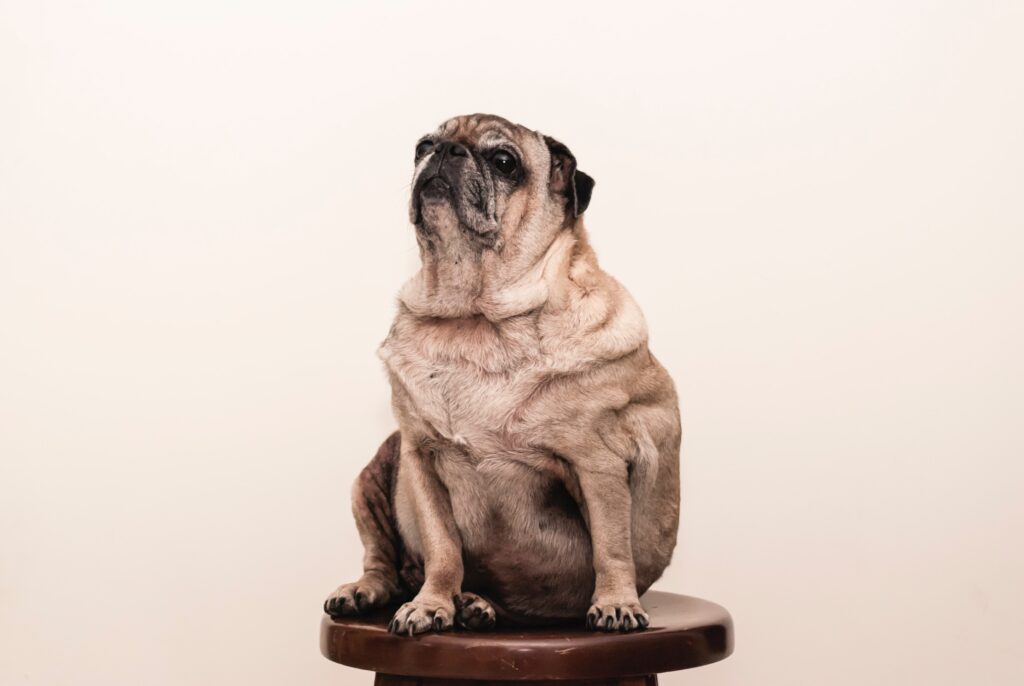Obesity is not only a growing concern in humans. Obesity levels in animals is increasing. Obesity can seriously affect your pet’s health and it is essential you are aware of it and tackle the problem.
What causes obesity?
There are many factors that may play a part in why your animal is overweight. But put simply we are either feeding our pets too many calories and/or they are not doing enough exercise.
Diet:
Diet is a tricky one! It can be very confusing to know how much to feed your pet and you may think you are doing the right thing, but it still may be causing your pet to be overweight. The amount of food fed varies greatly between individual animals and can change depending on lifestyle, breed, activity levels, age, metabolism, potential underlying diseases and neutering status for example. Different diets contain different amounts of calories so feeding a standard ‘cup’ changes the amount of energy your pet may be getting depending on the brand of food. To make this more confusing, the feeding guidelines on the packaging are just that; guidelines. Therefore, your animal may require more or less depending on the above factors mentioned.
Snacks and Treats:
Snacks are also a big player in why your animal may be looking a bit too rotund. Snacks should ALWAYS be counted in your animal’s daily intake and if they are being fed snacks for training or during the day to keep them busy (i.e. hiding treats in a Kong), the amount of normal dog food (e.g. biscuits) should be altered depending on this. It is easy to also underestimate the number of calories in human snacks when comparing it to the size of your pet. For example; feeding a slice of cheese (which doesn’t seem too much for a human), can be closer to the equivalent of your pet eating a burger.
Exercise:
Inactivity is another contributing factor. Sometimes it is very hard to find the time to exercise our pet. However, exercise burns calories and helps kept our pet’s trim and happy.

The health risks of obesity
Like humans, there are negative health concerns for your animal when they are overweight. Here are just a few:
- Arthritis: When your pet has extra weight, this puts strain and unwanted pressure on their joints. This can lead to earlier onset arthritis, or increased pain on already sore joints, especially in elderly animals.
- Shorten life-span: Studies have shown that obese animals do not live as long as animals that are kept lean.
- Diabetes Mellitus: Extra body fat can lead to insulin insensitivity and change the normal hormonal mechanisms in which your pet’s body regulates glucose.
- Respiratory problems: Some dog breeds such as the French Bulldog and Pug have shortened conformation of their nose and face (brachycephalic). Increased weight in these breeds increases their respiratory efforts and can lead to respiratory distress/compromise.
- Increased anaesthetic risk: Extra weight means added pressure to the chest cavity when patients are on their backs for procedures. Fat can also make surgeries harder due to the difficulty for the surgeon in handling fatty tissue, and fat can also have many small vessels which may ‘ooze’ during surgery. Having a larger amount of fat on the body can also make dosing with the correct amount of anaesthetic agent more difficult.
- Heart disease and hypertension
These are just a few health risks, but there are many others including; heat stress, dermatitis, exercise intolerance and an overall reduced quality of life.
How can you tell if your pet is overweight?
Your animal may show some signs which indicate it is overweight- such as difficulty getting around, breathing difficulties and lameness, to name a few. You can also measure body condition score (BCS) at home to assess your pet’s ideal weight. The three areas BCS have measured are:
- Along the ribs: You should always be able to feel an animal’s ribs but there should a little bit of cover. If you try to feel your animal’s ribs and can only feel skin and a good layer of covering, then you pet is likely overweight.
- Looking at the waist from a bird’s eye view: Looking down on your pet’s waist you should see a ‘dip’ between the abdomen and the hind legs. If your pet looks more ‘table top’ like, then they may be overweight
- Feeling along the spine: When you run your hands down your pet’s back you should be able to feel a hard line associated with their backbone. If this is difficult to palpate then this (along with other signs discussed) suggests your pet may be overweight.
What should you do if you think your pet may be overweight?
If you think your pet may be overweight, it is important for them to be assessed by your veterinarian. Weight will be measured along with assessing BCS and a thorough health check will be completed to check for possible underlying causes. If your animal is found to have too much excess weight, then a plan can be made to help them shed this weight in a healthy way to achieve a better body condition score; from the diet, adjustments to exercise plans and discussion of ongoing monitoring and management.
If you think this might be the case with your animal, book an appointment at the clinic and we can make sure they have the best opportunity for a healthy lifestyle and longevity!
